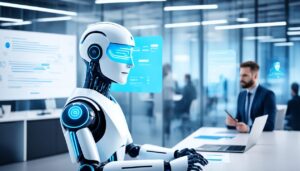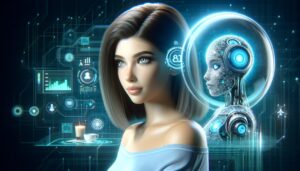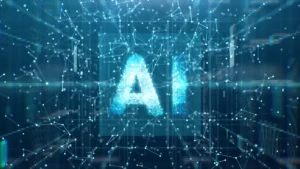In the tech-evolving era, robots and artificial intelligence continue to aid in multiple fields, providing solutions to ventures of all nature and sizes. A media and technology source, PwC, states that by 2030, AI will add 15.7 trillion dollars to the world GDP, and the global industrial robotics market will reach a staggering $60 billion in 2030.
While the robotic industry still needs a significant amount of assistance to make informed decisions, with the integration of artificial intelligence they will not just be able to perform tasks but will also help them to learn and adapt the changes
In this article, we will also discuss the role of AI in robotics, how synergy is pushing the boundaries, and how robotics is making smarter and more efficient.
What is Robotics?
Invented in the early 1950s, Robotics is a multidisciplinary field that integrates technology, mathematics, and computer science. The machines, which are known as robots, are capable of helping, improving, and even mimicking human activities.
While initially robotics was only limited to basic human assistance, with the involvement of AI, it is now known as an “intelligent tool.”
What is artificial intelligence (AI)?
AI is a field of technology and study that allows machines to imitate human activities and perform complex tasks like reasoning and learning. AI can be used in many areas including commerce, personal recommendations, learning, and visual design.
Are artificial intelligence and robotics the same?
In many instances, we experience people using the terms “robotics” and “artificial intelligence”, referring to the same technology. However, when differentiated, they have different sets of focus and applications.
Robotics, which was introduced before AI, explains the building of a machine, utilized to accelerate performance and perform a task in repetition. On the contrary, AI is designed to understand these machines, and how they can mimic human intelligence, including problem-solving and learning for better decision-making.
Robots that are trained with AI capabilities, can understand, integrate, and learn from the decisions in real-time. With AI, robots can interpret data, learn from experiences, and navigate human activities more effectively.
Nevertheless, AI and robotics are not similar and connected. While not intelligent and independent, robotics can function well without AI. Similarly, AI can also function without robots.
What is the role of artificial intelligence (AI) in robots?
Listed below are the points that explain the role of AI in robots or robotics;
- Can showcase informed decision-making
With robots following predefined instructions, they limit their ability to adapt to changing environments. However, with the integration of AI in robots, they can analyze vast amounts of informational data, making decisions for better accuracy and efficiency.
For instance, in August 2020, a scientist at the University of Liverpool discovered a robot chemist that conducts experiments by itself.
The robot, integrated with AI, along with carrying out simpler lab work, can accelerate scientific discovery by managing complex problems.
A scientist among the inventors explained “This creates a level of flexibility that will change both the way we work and the problems we can tackle. This is not just another machine in the lab: it’s a new superpowered team member, and it frees up time for the human researchers to think creatively.”
- Enables Adaptation and learning from experiences
Machine learning, which is a subset of AI, enables robots to learn from experience and adapt to the environment. Unlike conventional learning, where the robots have functioned with a repeated learning process, intelligent robots can observe patterns, and recognize, and adapt behavior.
For instance, a robot in the warehouse learns the most efficient route to navigate and adapts to the different placements.
- Autonomy and Automation
AI, the driving force behind the accelerating economy, helps robots in practicing tasks with the involvement of humans. An autonomous robot, integrated with AI, can make decisions, execute actions, and solve problems. Such practices have led to advancements including automation in the growing industries like logistics, science, and mechanics.
- Make them more user-friendly
While initially, robots had strict working, the incorporation of AI makes them more friendly and interactive. Through the natural language, emotion recognition, and understanding, AI-powered robots can collaborate with people more effectively
For instance, AI-enabled robots for humans can understand non-verbally whereas robots improve user selection.
What are the applications of artificial intelligence?
Artificial intelligence has accelerated capabilities that allow it to grow efficiently. Here are some of the applications of AI;
- Industrial Robotics
AI-driven robotics are optimized products and have revolutionized the assembly lines, logistics, and assembly. They use machine learning and robotics.
- Healthcare Robotics
In the medical field, artificial intelligence plays an important role in surgical rehabilitation, and elderly care. Global data states that the surgical robotics market is expected to expand by a CAGR of 8 percent.
- Service Robotics
It enhances the functionality of services across several domains including service robotics. It utilizes AI for optimization and obstacle avoidance.
Wrapping Up
As artificial intelligence and robotics continue to advance, AI integration into robots is transforming daily life in numerous ways.
However, the numerous evolution has the responsibility of AI development. Ensuring that AI is designed with security, fairness, and transparency.
By prioritizing responsibility and progress, one can harness the potential of AI in robotics.
Related: Can AI Be The Official Employee? Experts Say “We Have a Choice”
Related: LinkedIn Develops Its AI-Powered Security Platform: Here’s Why!
Related: Dell Fires At Least 12,500 Employees Amid AI Incorporation: Report







